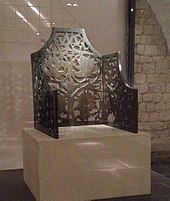17:
25:
42:
92:
bronze castings. The plinth and enclosure of the throne are made of sandstone and date to the 13th century. Its sides are decorated with
178:
164:
198:
20:
Imperial throne, Goslar: sandstone plinth and enclosure, about 1220, and replica of the bronze parts; porch of St. Simon and Jude
139:. The plinth and enclosure with a replica of the bronze parts are in the remaining northern porch of St. Simon and Jude.
203:
123:
until its demolition (1819–1822) and was then sold. Passing through various hands, it came into the possession of
136:
132:
128:
124:
62:
16:
112:- whose shape it resembles - the Goslar imperial throne is the only surviving medieval throne of a Holy Roman
127:
in 1871 and was used for the last time in an imperial ceremony at the opening of the first Berlin
97:
54:
174:
160:
120:
135:. Charles left the throne in his will to the town of Goslar. It is now in the vaults of the
58:
193:
84:
hill. The cast sides with their luxurious, swirling decorations, pomegranates and pierced
46:
187:
101:
76:
The throne comprises three sides (a backrest and two armrests), which were cast from
73:
it is one of the most important, surviving artefacts from the demolished cathedral.
105:
81:
70:
85:
24:
28:
Imperial throne, Goslar: original bronze parts, about 1070; imperial palace
53:) was made in the second half of the 11th century and was the throne of
113:
109:
93:
89:
77:
80:, and a stone plinth with a seat. The metal was mined in the nearby
23:
15:
155:
Müller, Ursula; Griep, Hans-Günther and
Schadach, Volker (2000).
57:
and kings in the
Collegiate Church of St. Simon and St. Jude ("
169:Gutmann, Christoph and Schadach, Volker (2002).
8:
61:"), which stood in the grounds of the
7:
152:, Verlag Goslarsche Zeitung, Goslar.
88:leaves are among the most important
173:, Verlag Volker Schadach, Goslar,
159:, Verlag Volker Schadach, Goslar,
14:
119:The imperial throne stood in the
1:
148:Griep, Hans-Günther (1988).
220:
137:Imperial Palace of Goslar
125:Prince Charles of Prussia
63:Imperial Palace of Goslar
150:Goslar – Der Pfalzbezirk
199:History of Lower Saxony
131:as the seat of Emperor
50:
29:
21:
27:
19:
98:legendary creatures
55:Holy Roman Emperors
204:Individual thrones
171:Kaiserpfalz Goslar
157:Kaiserstadt Goslar
69:). Along with the
67:Kaiserpfalz Goslar
51:Kaiserstuhl Goslar
30:
22:
121:Collegiate Church
100:. Apart from the
211:
59:Goslar Cathedral
45:
219:
218:
214:
213:
212:
210:
209:
208:
184:
183:
145:
41:
34:imperial throne
12:
11:
5:
217:
215:
207:
206:
201:
196:
186:
185:
182:
181:
167:
153:
144:
141:
13:
10:
9:
6:
4:
3:
2:
216:
205:
202:
200:
197:
195:
192:
191:
189:
180:
179:3-928728-52-0
176:
172:
168:
166:
165:3-928728-48-2
162:
158:
154:
151:
147:
146:
142:
140:
138:
134:
130:
126:
122:
117:
115:
111:
107:
103:
102:Aachen Throne
99:
95:
91:
87:
83:
79:
74:
72:
68:
64:
60:
56:
52:
48:
44:
39:
35:
26:
18:
170:
156:
149:
118:
96:figures and
75:
66:
37:
33:
31:
106:Charlemagne
82:Rammelsberg
71:Krodo Altar
188:Categories
133:William I
129:Reichstag
43:‹See Tfd›
86:palmetto
143:Sources
114:emperor
194:Goslar
177:
163:
110:Aachen
94:animal
90:Salian
78:bronze
47:German
38:Goslar
175:ISBN
161:ISBN
32:The
108:in
104:of
36:at
190::
116:.
49::
65:(
40:(
Text is available under the Creative Commons Attribution-ShareAlike License. Additional terms may apply.

